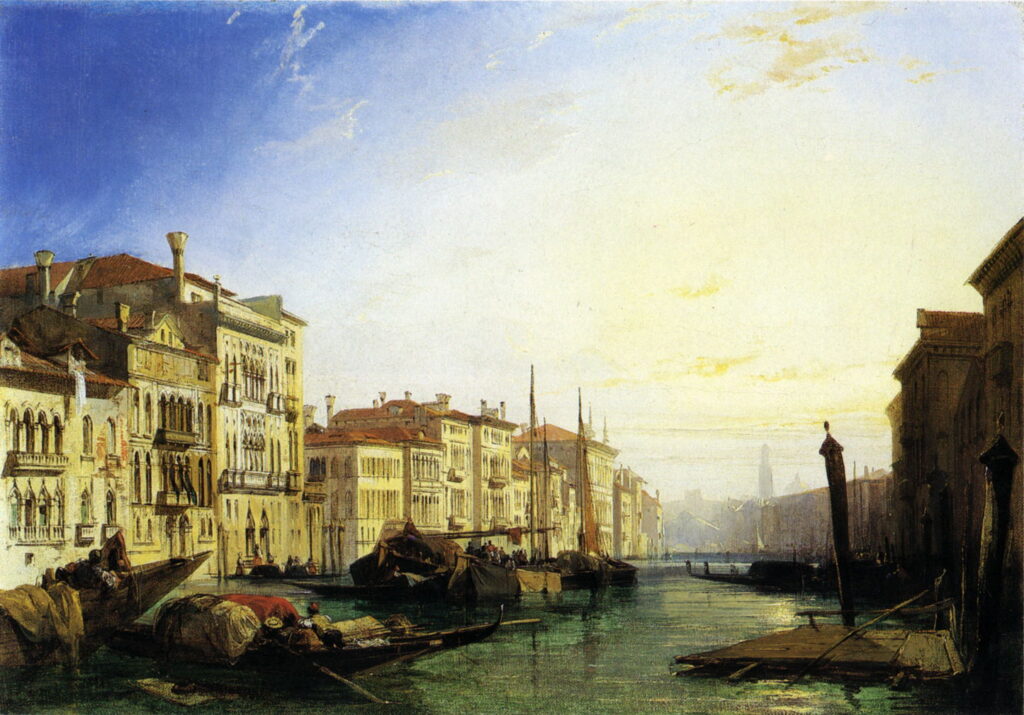Canals of Venice: 1825-1870

Few cities in Europe have been painted as much as Venice, with its distinctive canals and other waterways. First popularised by Giovanni Antonio Canal (1697–1768), better known as Canaletto, a native of the city whose vedute (views) sold so well to rich tourists undertaking their Grand Tours during the eighteenth century, they had faded by the start of the nineteenth.
In this series of four articles, I show how they were revived in the paintings of visiting artists, and played important roles in the development of twentieth century art. We start today with an English painter who was only twenty-three years old, and was to die within two years: Richard Parkes Bonington.
Richard Parkes Bonington (1802–1828), On the Grand Canal (1826) (240), oil on millboard, 23.5 x 34.8 cm, Yale Center for British Art, New Haven, CT. Wikimedia Commons.
On the Grand Canal (1826) is a brilliant plein air oil sketch painted from a boat, showing the entrance to the Grand Canal, which snakes its way through the centre of the city. Bonington has removed one of the palazzi, but otherwise appears faithful to the motif.
Richard Parkes Bonington (1802–1828), Riva degli Schiavoni, from near S. Biagio (c 1827) (237), watercolour and bodycolour over graphite, 17.7 x 17 cm, Museum of Fine Arts, Boston, MA. Wikimedia Commons.
Riva degli Schiavoni, from near S. Biagio (c 1827) shows the San Marco basin from the Arsenal traghetto, near the south-eastern entrance to the Grand Canal. Although only a small watercolour, Noon considers it was painted well after Bonington’s return from Italy.
Richard Parkes Bonington (1802–1828), Ducal Palace with a Religious Procession (1827) (230), oil on canvas, 114 x 163 cm, The Tate Gallery, London (Presented by Frederick John Nettlefold 1947). Photographic Rights © Tate 2016, CC-BY-NC-ND 3.0 (Unported), http://www.tate.org.uk/art/artworks/bonington-venice-ducal-palace-with-a-religious-procession-n05789
Ducal Palace with a Religious Procession (1827) was apparently painted in late 1827 for James Carpenter, from graphite studies Bonington had made during his visit in 1826. Painted on a white ground, it unfortunately underwent severe shrinkage, and was extensively retouched as a result. However, it was generally very well received at the time, despite the liberties taken with its representation of the view.
Richard Parkes Bonington (1802–1828), Grand Canal, the Rialto in the Distance – Sunrise (1828) (242), oil on canvas, 43 x 61 cm, Private collection. Wikimedia Commons.
Grand Canal, the Rialto in the Distance – Sunrise (1828) is one of Bonington’s finest oil paintings, made in the studio from graphite and other sketches from 1826. This painting has quite commonly been described as showing sunset, but as the view faces almost due east, must have been set in the early morning.
Richard Parkes Bonington (1802–1828), The Grand Canal Looking Toward the Rialto (1826) (244), oil on millboard, 35.2 x 45.4 cm, Kimbell Art Museum, Fort Worth, TX. Wikimedia Commons.
The Grand Canal Looking Toward the Rialto (1826), painted on millboard, may have been started en plein air, but appears to have been completed later in the studio, when Bonington had returned to Paris, which may account for the difference in hues in the sky. By the summer of 1828, Bonington was back in London, where he died of tuberculosis at the age of only twenty-five.
Edward Lear (1812–1888), Venice, the Doge’s Palace (date not known), watercolor with pen in brown ink over graphite and, gouache on wove paper on medium, moderately textured, cream wove paper, 17.8 x 25.2 cm, Yale Center for British Art, New Haven, CT. Wikimedia Commons.
Between 1838-1848, the English traveller, writer and painter Edward Lear lived in Rome, making occasional visits to Britain. This quick plein air watercolour sketch of Venice, the Doge’s Palace is undated, but may well have been painted during this period.
JMW Turner paid many visits to Venice, where he painted some of his most radical landscapes.
Joseph Mallord William Turner (1775-1851), Campo Santo, Venice (1842), oil on canvas, 62.2 x 92.7 cm, Toledo Museum of Art, Toledo. WikiArt.
Although Turner wasn’t particularly consistent in his reflections, at his most faithful he remains accurate in this famous view of Campo Santo, Venice from 1842, where reflected sails appear angelic in form.
Joseph Mallord William Turner (1775–1851), The Dogano, San Giorgio, Citella, from the Steps of the Europa (1842), oil on canvas, 61.6 x 92.7 cm, The Tate Gallery (Presented by Robert Vernon 1847), London. © The Tate Gallery and Photographic Rights © Tate (2016), CC-BY-NC-ND 3.0 (Unported), http://www.tate.org.uk/art/artworks/turner-the-dogano-san-giorgio-citella-from-the-steps-of-the-europa-n00372
Turner’s clouds and buildings in The Dogano, San Giorgio, Citella, from the Steps of the Europa, from the same year, have a similar softness in form typical of his later oil paintings.
John Ferguson Weir (1841-1926), The Grand Canal, Venice (1869), oil on canvas, 121.9 x 91.4 cm, Mattatuck Museum Arts and History Center, Waterbury, CT. The Athenaeum.
John Ferguson Weir visited the city in 1868, following which he painted The Grand Canal, Venice (1869) in the studio, probably when he was back in the USA in the autumn of the following year.
Next Sunday, I’ll show paintings from the closing years of the nineteenth century, when Venice became even more popular.



